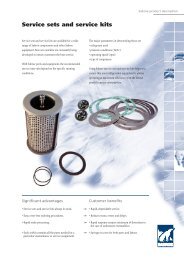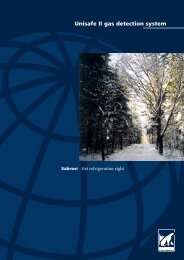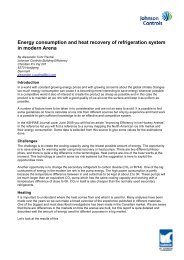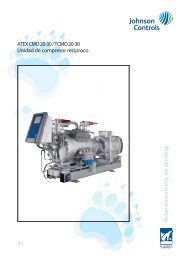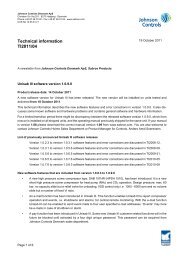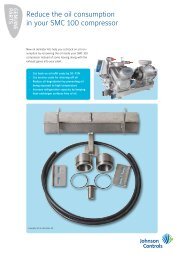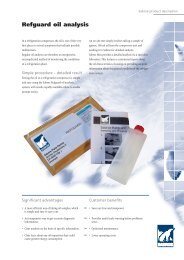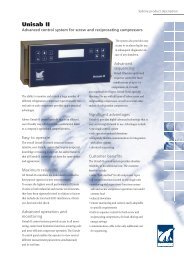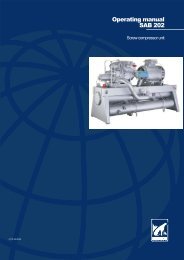Instruction Manual SMC 186-188/TSMC 188
Instruction Manual SMC 186-188/TSMC 188
Instruction Manual SMC 186-188/TSMC 188
Create successful ePaper yourself
Turn your PDF publications into a flip-book with our unique Google optimized e-Paper software.
We would, therefore, advise that the oil analyses<br />
be carried out at the intervals prescribed.<br />
An oil sample must be drawn off while the<br />
compressor is in operation, which gives a<br />
representative sample. Before taking the<br />
sample, clean the drain valve and tap a little<br />
oil off, to prevent any impurities which may<br />
have accumulated in the valve or the piping<br />
from mixing with the sample.<br />
As a special offer to our customers<br />
SABROE has developed an analytical concept,<br />
which is able to analyse all oil makes.<br />
This will mean a uniform reporting of the results.<br />
The analysis allows the following to be determined:<br />
S<br />
Whether or not the oil is still usable, if necessary<br />
after filtering.<br />
Visual assessment<br />
If you pour the sample into a clean, transparent<br />
glass bottle or a test-tube and hold it up<br />
to a clear light source, it will be easy to assess<br />
the quality. You can also compare the<br />
sample with the fresh oil of the same make<br />
and grade.<br />
An oil which you approve on the grounds of a<br />
visual assessment must:<br />
S<br />
S<br />
be clear and shiny<br />
not contain any visible particles<br />
S<br />
S<br />
Whether solid particles possibly present in<br />
the oil originate from the bearings or other<br />
components exposed to wear and tear in<br />
which case the compressor must be inspected.<br />
Each report will include the corresponding<br />
measuring results from theprevious3oil<br />
analyses. In this way you will be able to<br />
follow up on the state of both the oil and<br />
the compressor from one analysis to the<br />
next.<br />
S<br />
feel viscous, smooth and greasy when a<br />
drop is rubbed between two fingers.<br />
If you don’t feel that you can approve the oil<br />
by visual assessment, charge with new oil or<br />
send a sample to a laboratory for analysis.<br />
Warning<br />
If the oil sample is poured into a glass bottle,<br />
this must not be hermetically sealed until all<br />
the refrigerant in the oil sample has evaporated.<br />
Refrigerant in the oil may produce excess<br />
pressure in the bottle with subsequent<br />
risks of explosion. Never fill a bottle up completely.<br />
Do not send glass bottles through<br />
the postal service -- use purpose-made plastic<br />
bottles. Please see below.<br />
Procedure<br />
S<br />
S<br />
A form set with a plastic sampling bottle<br />
and a dispatching envelope can be requested<br />
from the local Sabroe Refrigeration<br />
representation.<br />
The oil sample must be drained from the<br />
cleaned oil drain valve into the sample<br />
bottle. Screw the lid loosely on and let the<br />
bottle stand for a few hours to enable refrigerant<br />
contained in the oil sample to<br />
evaporate before sending it to the laboratory.<br />
Analytical evaluation<br />
Naturally, the oil sample can be analysed by<br />
the oil company which supplies the oil.<br />
S<br />
Please follow the Sampling and Shipping<br />
<strong>Instruction</strong>s enclosed in the form set in<br />
which the addresses of the laboratory in<br />
Holland are also mentioned.<br />
0178-900-EN 41



